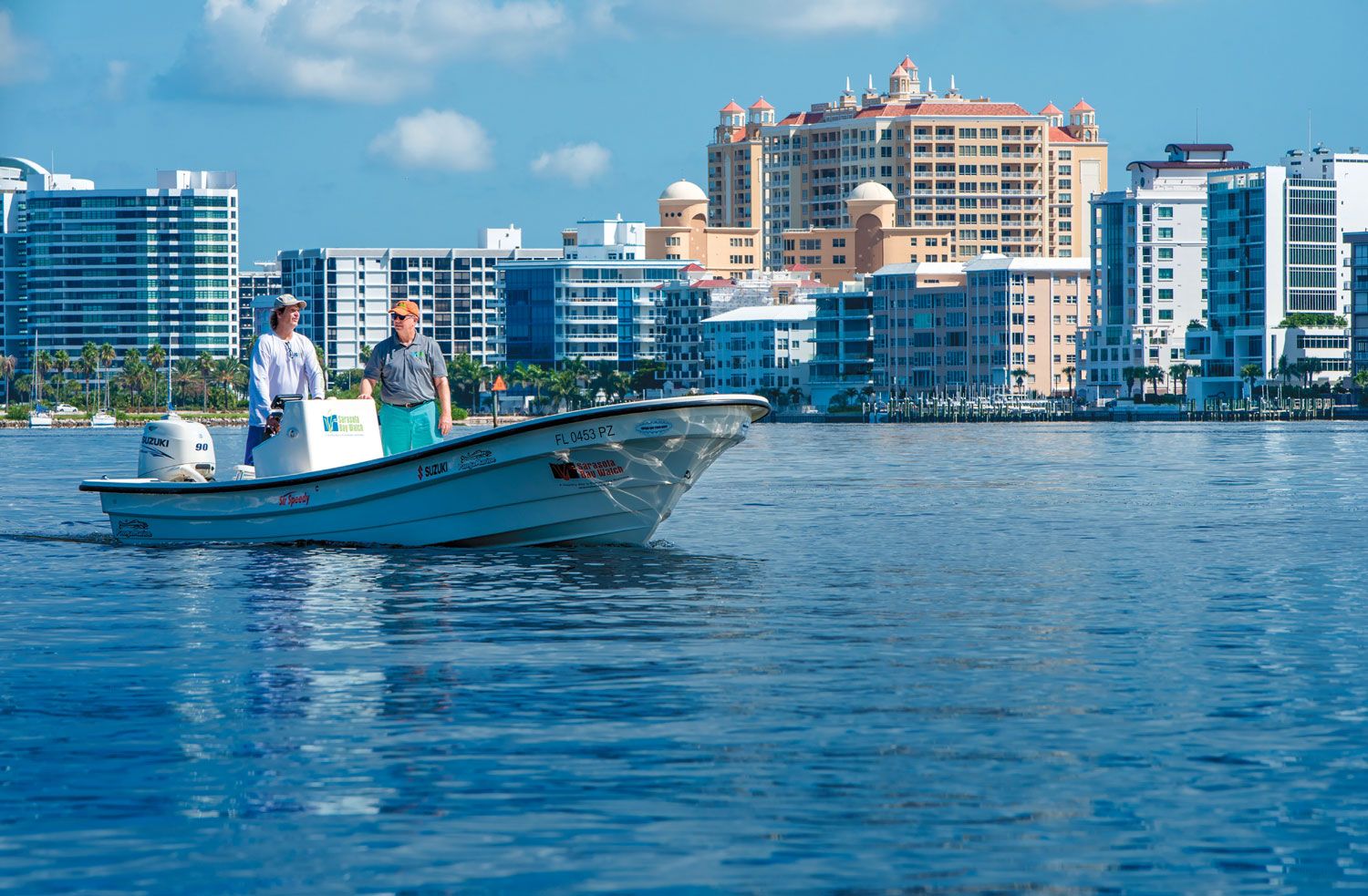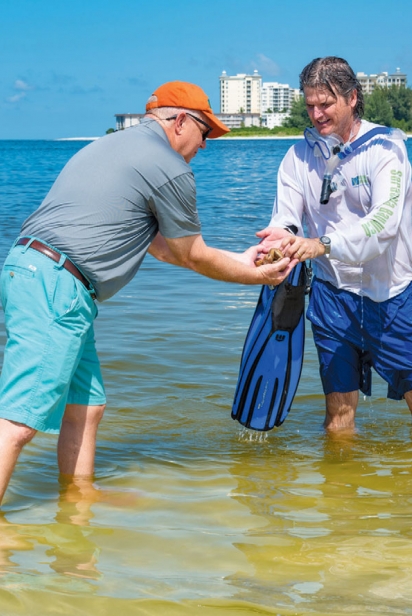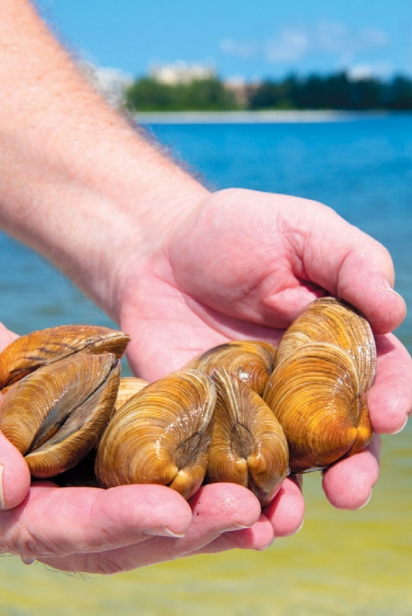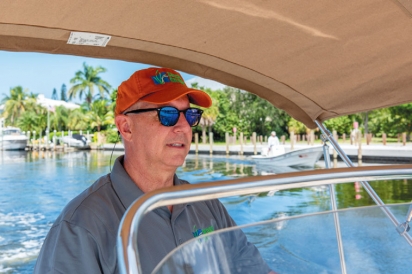On Behalf of Our Water
As the water gets clearer and marine life slowly recovers; as the sand returns to powdery white and fills once again with beachgoers, the red tide hangover looms—physically and economically—driving Sarasota residents to elevate efforts for the health and vitality of local waterways.
“It starts in our homes and businesses and extends throughout the community to civil servants and our elected officials,” says Larry Stults, president of Sarasota Baywatch, a nonprofit organization dedicated to preserving and restoring Sarasota Bay’s ecosystem.
“Red tide is a complicated issue with a lot of variables, and it’s easy to try to look for a single culprit,” says Stults. “We have to look across a number of contributing factors but also a number of solutions.”
Red tide, caused by the Karenia brevis organism, is a naturally occurring algal bloom and an ecological phenomenon in Gulf Coast waters throughout documented history. It affects marine life and can give off neurotoxins that irritate land-dwellers, including humans. K. brevis movement is influenced by weather patterns, tide changes and salinity levels, but in the wake of this year’s catastrophic bloom, the correlation of human and agricultural activity to bloom dynamics has gained massive recognition. Although yet to be scientifically proven, one popular theory is that increased nutrient levels in stormwater runoff fuel the microscopic K. brevis, contributing directly to this year’s intensity and duration.
“I am not a scientist, but when I see a lot of rain, red tide is usually soon to follow,” says Captain Rick Grasset, a local fly fishing guide who’s been fishing the area for 29 years. Throughout his time in in local waters, Grasset, who monitors red tide levels regularly, says the area has never completely been free of red tide. Over the years, he’s noticed regular and higher concentrations in areas surrounded by waterfront residences.
While eliminating the use of commercial fertilizers and glyphosate herbicides would be a start, there are many other practices that could not only reduce human nitrogen and phosphorus inputs, but also better manage and control runoff, especially from intense rain events.
“Picture what that water picks up along the way and then think that is going to end up in the bay,” says Justin Bloom, executive director of Suncoast Waterkeeper, whose mission is to protect and restore the Florida Suncoast’s waterways. “It could be fertilizer from your lawn, or grass clippings, or pet waste,” he says.
Residents not able to connect to centralized sewer systems should be regularly maintaining their septic systems as well. Grass clippings should be composted or sent to the landfill. Removal of pet waste from the sidewalk and other people’s yards is not enough. It needs to be picked up from the yard and sent to the landfill for proper containment. Incorporating pervious materials, bioswales, rain barrels, and rain gardens in your landscaping can help by capturing rainwater and preventing the channelization of forceful runoff straight to the Bay.
“Even if there were no red tide, we are in a water crisis in the state of Florida,” says Bloom “So, all these things we need to do to address red tide—we need to do anyway.”
In addition to daily practices, bolstering marine life and land conservation, as well as the protection and restoration of wetlands, is essential. Wetlands not only create wildlife habitats but manage nitrogen.
“Wetlands filter out 90% of the most common pollutants, such as nutrients out of moving waters,” states Dr. Abbey Tyrna, water resources agent for UF/IFAS Extension and Sustainability Sarasota County, in a May 2018 blog post.
In terms of marine life conservation, organizations like Sarasota Bay Watch and individuals like Captain Grasset are offering additional solutions, including restoring the shellfish population that once was abundant in our bays and protecting local fish species.
“Shellfish are Mother Nature’s cleaners, working 24 hours a day, seven days a week, filtering the water. That’s what they do,” says Stults, adding, “If you can rebuild the foundation of the food chain, the diversity of the bay increases, the resilience of the bay to challenges like red tide improves, the number of animals in the bay increases, as does the people’s enjoyment of the bay, so everybody wins.”
As part of the Coastal Conservation Association, Grasset is proud of recent efforts to limit snook and redfish to catch-and-release in red-tide affected areas, but feels more should be done to protect and replenish local fish species.
“People need to be conservation-minded,” he says. “Just because the law is going to allow you to kill ‘X’ amount of fish, doesn’t mean you should.”
While these efforts will not completely prevent red tide, if collectively put into action there is no doubt they will improve the overall health of the water that supports our Gulf Coast community—from its tourism to its seafood.
“Protecting our bays and the Gulf of Mexico from excess nutrient pollution is a year-round job, and everyone has a role to play,” says Stults. “A healthy bay is everybody’s business.”
UPCOMING EVENT:
November 15 at 6 p.m. Water Issue Panel Discussion, location TBD
WEBSITES TO FOLLOW:
Can I eat local seafood?
According to the Florida Fish and Wildlife Commission, local seafood can be consumed after and even during red tide blooms ... with exceptions.
Restaurant-served shellfish are said to be OK because they are government monitored. Commercial locally harvested shellfish are tested for red tide toxin before they are sold so those are safe as well.
Recreationally harvested clams, scallops, oysters, and mussels harvested during or just following blooms should not be consumed.
Edible parts of other crabs, shrimp, and lobsters are not affected by the red tide organism and can be eaten.
Because filleting finfish rids them of their guts, which accumulate toxins, it is safe to eat locally caught finfish as long as they are properly filleted.
It is never safe to eat dead or distressed fish.
What can I do?
• Clean up pet waste in your yard—not just on walks.
• Pick up grass clippings—compost or send to landfill.
• Install rain barrels to collect rainwater (sfyl.ifas.ufl.edu/sarasota/gardening-and-landscaping/horticulture-residential/florida-yards-and-neighborhoods/rain-barrels)
• Use pervious material such as pavers to allow water to percolate.
• Avoid commercial fertilizers and herbicides, altogether if possible, but especially during rainy seasons.
• Maintain septic systems and/or connect to centralized sewer as soon as possible.
• Support local water and land advocacy groups such as Captains for Clean Water, Suncoast Waterkeeper, and Sarasota Bay Watch, and the Conservation Foundation of the Gulf Coast (to name just a few).
• Plant rain gardens to collect and utilize rainwater.
• Vote for public officials who advocate for water quality.
• Shop and buy local. Many of our businesses are in need of support!









